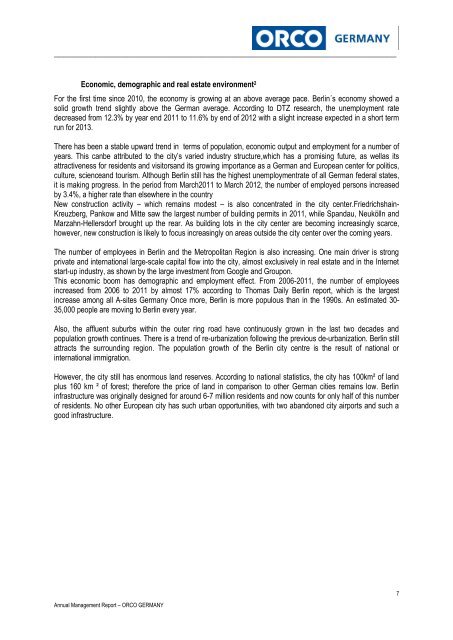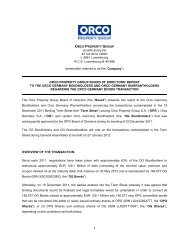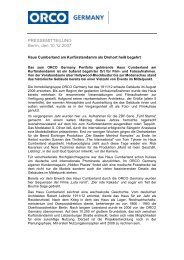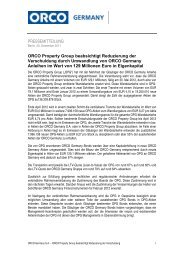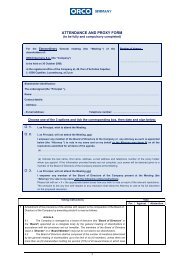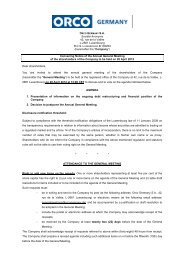Annual Report 2012 - ORCO Germany
Annual Report 2012 - ORCO Germany
Annual Report 2012 - ORCO Germany
You also want an ePaper? Increase the reach of your titles
YUMPU automatically turns print PDFs into web optimized ePapers that Google loves.
___________________________________________________________________________<br />
Economic, demographic and real estate environment 2<br />
For the first time since 2010, the economy is growing at an above average pace. Berlin´s economy showed a<br />
solid growth trend slightly above the German average. According to DTZ research, the unemployment rate<br />
decreased from 12.3% by year end 2011 to 11.6% by end of <strong>2012</strong> with a slight increase expected in a short term<br />
run for 2013.<br />
There has been a stable upward trend in terms of population, economic output and employment for a number of<br />
years. This canbe attributed to the city’s varied industry structure,which has a promising future, as wellas its<br />
attractiveness for residents and visitorsand its growing importance as a German and European center for politics,<br />
culture, scienceand tourism. Although Berlin still has the highest unemploymentrate of all German federal states,<br />
it is making progress. In the period from March2011 to March <strong>2012</strong>, the number of employed persons increased<br />
by 3.4%, a higher rate than elsewhere in the country<br />
New construction activity – which remains modest – is also concentrated in the city center.Friedrichshain-<br />
Kreuzberg, Pankow and Mitte saw the largest number of building permits in 2011, while Spandau, Neukölln and<br />
Marzahn-Hellersdorf brought up the rear. As building lots in the city center are becoming increasingly scarce,<br />
however, new construction is likely to focus increasingly on areas outside the city center over the coming years.<br />
The number of employees in Berlin and the Metropolitan Region is also increasing. One main driver is strong<br />
private and international large-scale capital flow into the city, almost exclusively in real estate and in the Internet<br />
start-up industry, as shown by the large investment from Google and Groupon.<br />
This economic boom has demographic and employment effect. From 2006-2011, the number of employees<br />
increased from 2006 to 2011 by almost 17% according to Thomas Daily Berlin report, which is the largest<br />
increase among all A-sites <strong>Germany</strong> Once more, Berlin is more populous than in the 1990s. An estimated 30-<br />
35,000 people are moving to Berlin every year.<br />
Also, the affluent suburbs within the outer ring road have continuously grown in the last two decades and<br />
population growth continues. There is a trend of re-urbanization following the previous de-urbanization. Berlin still<br />
attracts the surrounding region. The population growth of the Berlin city centre is the result of national or<br />
international immigration.<br />
However, the city still has enormous land reserves. According to national statistics, the city has 100km² of land<br />
plus 160 km ² of forest; therefore the price of land in comparison to other German cities remains low. Berlin<br />
infrastructure was originally designed for around 6-7 million residents and now counts for only half of this number<br />
of residents. No other European city has such urban opportunities, with two abandoned city airports and such a<br />
good infrastructure.<br />
<strong>Annual</strong> Management <strong>Report</strong> – <strong>ORCO</strong> GERMANY<br />
7


